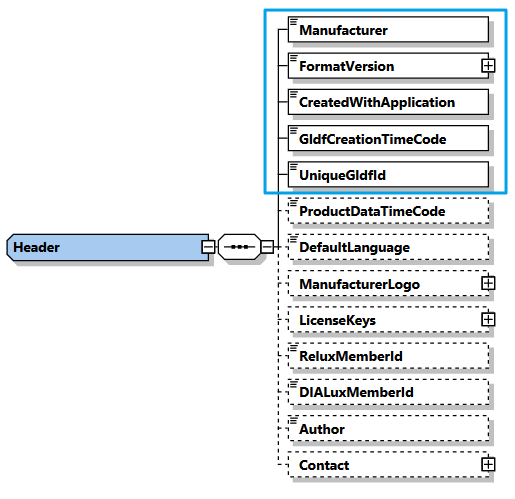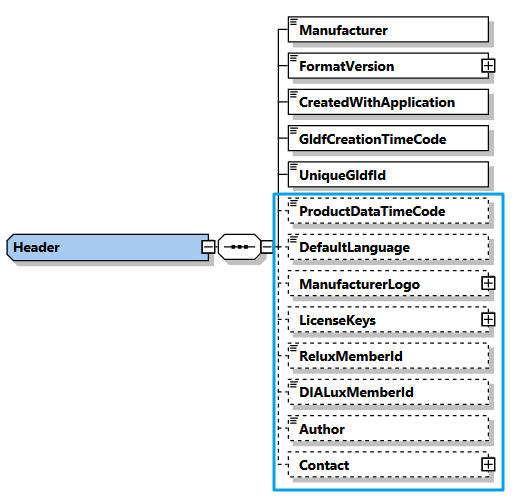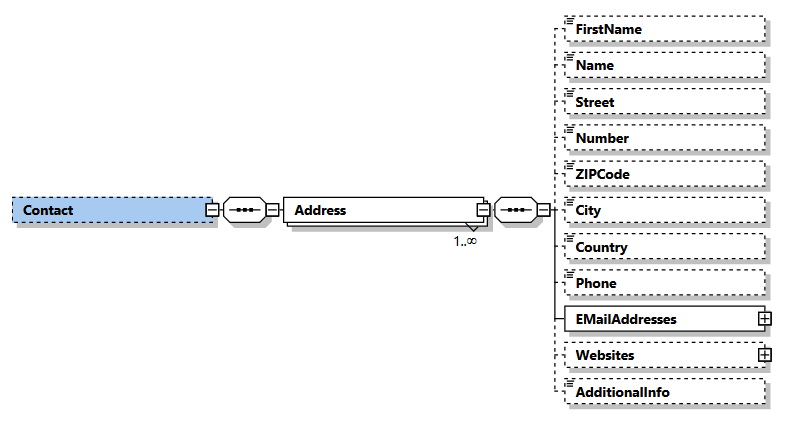Header
Header Description
The Header is the first part of the GLDF product.xml file und the first child element below Root. It contains meta-information about the manufacturer, contact information and the used GLDF version. As well as license information if applicable. It does not contain any product information yet.

Mandatory Header part
Some of the metadata are mandatory for every GLDF. They are intended to make it easier for users as well as applications to identify when, by whom, and how a GLDF was created. And which version of the format was used. Therefore every Header element must begin with 5 mandatory children:

Manufacturer
The probably most important element first: The manufacturer of the product inside the GLDF. Its typically the name of the company that produces and/or distributes the luminaire.FormatVersion
This element specifies the GLDF version in use. For versioning, we adhere to the SemVer standard. SemVer helps to determine if updates to the product.xml file are needed, particularly in cases of breaking changes. Or if a newer XSD can be referenced without risking data incompatibility.CreatedWithApplicationCreatedWithApplicationdescribes which application was used to create this GLDF file. Ths could be the name of the text editor the author used. The PIM system it was exported from, a software service running in background, an online GLDF editor or a data converter perhaps. This information can be very useful in debugging scenarios when something went wrong.GldfCreationTimeCodePlease refer to Timecodes whereGldfCreationTimeCode, and its counterpartProductDataTimeCode, are explained in detail.UniqueGldfId
For the last but not least important element please refer to Unique Ids. Caution: Never copyUniqueGldfIdbetween multiple GLDFs. Even not for the same product like in theUniqueProductIdelement. Create always a new id for each and every GLDF file you write and deploy. We strongly recommend to use UUIDS for this without exception.
Mandatory XML example
Here is an example of all mandatory child elements which each Header element in GLDF must contain. The Header itself is the first child of Root - the parent element of all content in GLDF. The example itself begins in line 5:
- Line 5: This GLDF is from the fictive manufacturer ACME.
- Line 6: It is based on the GLDF version 1.0-rc.3.
- Line 7: The IDE it was created with was Visual Studio Code.
- Line 8: The GLDF was created on October 19th 2023, at 05:30 Coordinated Universal Time (Z).
- Line 9: The worldwide unique id for this GLDF would be 93b821be-e4a6-4758-bc5e-7d98499fe664.
<?xml version="1.0" encoding="UTF-8"?>
<Root xmlns:xsi="http://www.w3.org/2001/XMLSchema-instance"
xsi:noNamespaceSchemaLocation="https://gldf.io/xsd/gldf/1.0.0-rc.3/gldf.xsd">
<Header>
<Manufacturer>ACME</Manufacturer>
<FormatVersion major="1" minor="0" pre-release="3" />
<CreatedWithApplication>Visual Studio Code</CreatedWithApplication>
<GldfCreationTimeCode>2023-10-19T05:30:00Z</GldfCreationTimeCode>
<UniqueGldfId>93b821be-e4a6-4758-bc5e-7d98499fe664</UniqueGldfId>
</Header>
<GeneralDefinitions>
<!-- Skipped for now -->
</GeneralDefinitions>
<ProductDefinitions>
<!-- Skipped for now -->
</ProductDefinitions>
</Root>
Optional Header part
The next part of the Header is not mandatory. However, we recommend to include details such as the manufacturer's image and contact information for potential customers. And especially member Ids for DIALux and RELUX as well as possibly further license information, should these be necessary for certain applications.

The highlighted child elements are described in more detail below.
ProductDataTimeCode
Please refer to Timecodes where ProductDataTimeCode and the difference to GldfCreationTimeCode are explained.
DefaultLanguage
Should the GLDF file provide multiple translations, DefaultLanguage specifies the language, that applications should use as a fallback when the user's current GUI language doesn't match any of the available translations. If DefaultLanguage is not provided, the implementation will be application-specific and preferably use English. See also Creating good GLDF files
The data type for DefaultLanguage is xs:language and has to be provided in lowercase as a 2-letter ISO 639-1 language code.
<DefaultLanguage>en</DefaultLanguage>
ManufacturerLogo
This element allows to distribute a manufacturer logo or image within the GLDF. You have to define the image as a File element first. And can then simply reference the File in the Header using the ManufacturerLogo element. Files can be either locally inside the GLDF Zip container or point to a file hosted online. See Files documentation for futher details.
An manufacturer logo hosted online could be written in GLDF like this:
<?xml version="1.0" encoding="UTF-8"?>
<Root xmlns:xsi="http://www.w3.org/2001/XMLSchema-instance"
xsi:noNamespaceSchemaLocation="https://gldf.io/xsd/gldf/1.0.0-rc.3/gldf.xsd">
<Header>
<Manufacturer>Manufacturer XY</Manufacturer>
<FormatVersion major="1" minor="0" pre-release="3" />
<CreatedWithApplication>Visual Studio Code</CreatedWithApplication>
<GldfCreationTimeCode>2023-09-17T09:30:47Z</GldfCreationTimeCode>
<UniqueGldfId>b1d2fd82-0402-4aaa-a8db-cefcf10d71ae</UniqueGldfId>
<ManufacturerLogo fileId="manufacturerLogo" />
</Header>
<GeneralDefinitions>
<Files>
<File id="manufacturerLogo" contentType="image/jpg"
type="url">https://example.org/logo.jpg</File>
</Files>
</GeneralDefinitions>
<ProductDefinitions>
<!-- Skipped for clarity -->
</ProductDefinitions>
</Root>
LicenseKeys
To fully utilize GLDF, you may need to add license keys, which can be provided by Relux, DIAL, or other third-party companies.

The content of the LicenseKey element shall be the string provided by the respective company. The application tag determines the software for which the license key is intended for.
<?xml version="1.0" encoding="UTF-8"?>
<Root xmlns:xsi="http://www.w3.org/2001/XMLSchema-instance"
xsi:noNamespaceSchemaLocation="https://gldf.io/xsd/gldf/1.0.0-rc.3/gldf.xsd">
<Header>
<Manufacturer>Manufacturer XY</Manufacturer>
<FormatVersion major="1" minor="0" pre-release="3" />
<CreatedWithApplication>Visual Studio Code</CreatedWithApplication>
<GldfCreationTimeCode>2023-09-17T09:30:47Z</GldfCreationTimeCode>
<UniqueGldfId>9be9f0c0-7ea2-442b-8a61-464e652772d7</UniqueGldfId>
<LicenseKeys>
<LicenseKey application="RELUX">Relux Key</LicenseKey>
<LicenseKey application="DIALux">DIALux Key</LicenseKey>
<LicenseKey application="3rd party app">Other Key</LicenseKey>
</LicenseKeys>
</Header>
<GeneralDefinitions/>
<ProductDefinitions>
<!-- Skipped for clarity -->
</ProductDefinitions>
</Root>
DIALux/Relux MemberId
DIAL and Relux may assign company IDs to manufacturers. These Ids will help DIALux and RELUX to associate GLDF files with a specific manufacturer and enable his membership feature set for GLDF.
See also Become a partner
<ReluxMemberId>Your Relux member id</ReluxMemberId>
<DIALuxMemberId>Your DIALux member id</DIALuxMemberId>
Author
The Author element describes the author of the GLDF file. This could be the name of an individual who made the file, a department, a contractor or simply the company.
<Author>Glowbert Lightenstein</Author>
Contact
This section holds contact information of the manufacturer. You can add multiple contacts. Most fields are strings and you can fill them as you wish - except for EMailAddresses and Hyperlink with a specific structure. At least one email is mandatory should you decide to add the Contact element to the Header.

<?xml version="1.0" encoding="UTF-8"?>
<Root xmlns:xsi="http://www.w3.org/2001/XMLSchema-instance"
xsi:noNamespaceSchemaLocation="https://gldf.io/xsd/gldf/1.0.0-rc.3/gldf.xsd">
<Header>
<Manufacturer>Manufacturer XY</Manufacturer>
<FormatVersion major="1" minor="0" pre-release="3" />
<CreatedWithApplication>Visual Studio Code</CreatedWithApplication>
<GldfCreationTimeCode>2023-09-17T09:30:47Z</GldfCreationTimeCode>
<UniqueGldfId>93b821be-e4a6-4758-bc5e-7d98499fe664</UniqueGldfId>
<Contact>
<Address>
<Name>Example Company</Name>
<Street>Main Street</Street>
<Number>42</Number>
<ZIPCode>10115</ZIPCode>
<City>Berlin</City>
<Country>Germany</Country>
<EMailAddresses>
<EMail mailto="support@example.org">Contact Support</EMail>
<EMail mailto="sales@example.org">Contact Sales</EMail>
</EMailAddresses>
<Websites>
<Hyperlink href="https://example.org">Our Website</Hyperlink>
<Hyperlink countryCode="uk"
href="https://uk.example.org">Our UK Website</Hyperlink>
<Hyperlink countryCode="de"
href="https://de.example.org">Our German Website</Hyperlink>
</Websites>
</Address>
</Contact>
</Header>
<GeneralDefinitions />
<ProductDefinitions>
<!-- Skipped for clarity -->
</ProductDefinitions>
</Root>